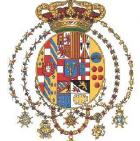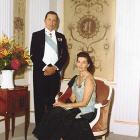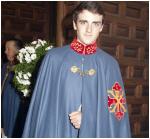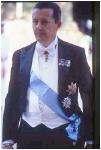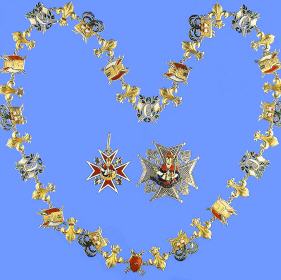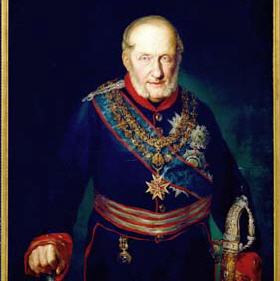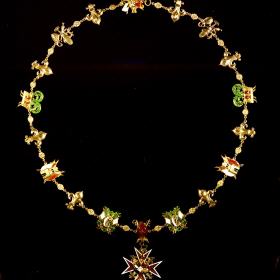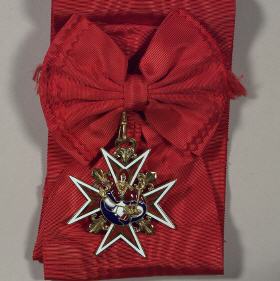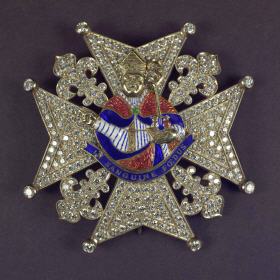HISTORY OF THE ROYAL ILLUSTRIUOS ORDER OF ST. JANUARIUS
© Guy Stair Sainty
The founder of the Order of Saint Januarius, Charles VII, King of the Two Sicilies (from 1734-1759, died 1788), was the first reigning Monarch to reside in this kingdom since 1502. Of unusual intelligence and benevolent disposition, Charles embarked on a series of reforms, to the considerable benefit of the people of his new dominions, who no longer endured the rule of a Viceroy representing a distant Sovereign. Since the kingdoms were surrounded on three sides by the sea and were bordered on the fourth by the Papal States, considered by a loyal Catholic Monarch to be inviolable, there was no room for further expansion. Hence, the king was able to concentrate his energies on beautifying his capital, paying off the National Debt (accomplished in a particularly short time) and reducing taxation.
Charles's Habsburg predecessors had used the resources of the Two Sicilies to subsidize their armies. The young King, in contrast, put all his energies into firmly establishing his authority, building the Palace of Caserta (the largest in Europe after Versailles), founding the Capodimonte porcelain factory (with the assistance of specialists from Meissen brought to Naples by his Queen) and sponsoring the excavations at Herculaneum and Pompeii. The latter made Naples, already the largest European city after Paris, with a population of between four and five hundred thousand, the most popular tourist attraction in Europe and brought considerable numbers of free-spending foreign visitors. The Royal Palace at Portici, constructed at the foot of Mount Vesuvius and directly above Herculaneum, contained the first public archaeological museum and the Royal Family were frequent visitors to the excavations. The construction of the San Carlo theater gave Naples one of the finest opera houses in Europe, and the establishment of the Reale Albergo dei Poveri, the first government-sponsored home for the underprivileged.
Charles, as a young Monarch, was considerably influenced by his father Philip V, King of Spain. Philip had proved a highly capable ruler, not only bringing peace to his Kingdom but in ultimately re-establishing Spanish influence in Italy. The interchange between the two Kingdoms remained a constant feature of international relations and insured the passage of the three Family Pacts of the eighteenth century between Spain, France and the Two Sicilies in 1733, 1743 and 1761. It is hardly surprising that the young King Charles VII of the Two Sicilies looked to his father for advice in administering the affairs of his Kingdom. Spanish forces had placed him on the Neapolitan Throne and he was surrounded by Spanish advisers, or men whose dislike of the Habsburg Viceroys administering their state on behalf of an absentee Sovereign, had led them to support the Spanish invasion and the accession of Charles as their King.
Italian writers, however, have ignored the influence of King Philip and Charles's extensive correspondence with his father, and the names of those knights of Saint Januarius whose nominations were made at the instigation of King Philip. The late Don Achille Di Lorenzo, author of a 1963 partial Roll of the Order, not only omitted these names but in a subsequent publication stated that he could not consider them legal since, in his view, a foreign sovereign could not intervene in the affairs of another Kingdom. The reality is, however, that the correspondence between Charles and Philip survives in the Spanish archives and demonstrates the contrary. We learn from this that various nominations to the Order were made at King Philip's instigation and they are amply documented. Furthermore, King Philip himself invested many of these knights with their collars personally, at his court in Madrid, acting with the consent of his son, King Charles.
Charles first proposed the idea of founding a new Order of Chivalry to his father soon after the successful invasion of Naples in 1735. In a letter from Philip s Minister, the Count of Santisteban, of 15 June 1735, the new King was advised to wait until after his formal investiture with the Crown of the two Kingdoms. The following month Santisteban informed King Philip (6 July 1735) that King Charles intended to go ahead with the foundation of this new Order; appropriately, it was to be named for the patron Saint of his capital, the Bishop-Martyr Januarius.[1]. The older Monarch approved the idea but recommended that his son send him the projected constitution and statutes before publication. On 30 August 1735 Santisteban wrote to King Philip again, informing him that King Charles had decided it should have sixty knights and suggesting the names of the first nineteen members. His father proposed that he should wait for a suitable occasion, in a reply of 29 October, but that occasion did not arise for another three years.
Charles' plans were further advanced by mid-1737 and on 21 June 1737 King Philip wrote to him once again expressing approval of the idea. Charles had already suggested the formation of a class of Magnates of the Kingdom, paralleling the Spanish Grandeeship, an idea that was supported by King Philip (letter of 23 December 1736), who later suggested the names of candidates.[2] This project was ultimately abandoned because of disagreements among the Two Sicilies nobility, and the problems this project seemed to foment encouraged Charles to return to the concept of founding a new Order. In mid-1738 his marriage to Maria Amalia Walburga, eldest surviving daughter of Friedrich August II, Elector of Saxony (August III, King of Poland), proved to be the opportunity he needed.[3]
Little is known of Saint Januarius beyond the fact that he was Bishop of Benevento and was martyred at Pozzuoli with six companions, circa 305. As a finger was cut off during the martyrdom a phial of blood was obtained, which is preserved in the Cathedral of Naples. This relic is exposed to the public on various occasions during the year, when, after an interval of time it liquefies; if it fails to do so then it is considered a portent of ill-fortune for the city. This phenomenon, which has been recorded for the past five hundred years, has been carefully observed and no satisfactory rational explanation has been produced to discount the miraculous nature of the liquefaction. Saint Januarius, who is often invoked against eruptions of Vesuvius, is portrayed on the badge of the Order holding a book with two phials of blood and the motto "In Sanguine Foedus".
The comparatively late foundation date of this institution makes it the last great dynastic Order to be constituted as a Chivalric fraternity rather than a National Merit Order. The Scottish Order of the Thistle had been created from a mythical past by James II in 1687 and its Sovereignty assumed by his successors, while the Russian Emperor had founded his Order of Saint Andrew just forty years earlier.[4] In 1701 the King of Prussia had founded the Order of the Black Eagle to mark his own elevation to Kingly rank. With the decision to announce the formation of the Order to coincide with his marriage, a firm date was set for July 1738. King Charles's Ambassador, the Count of Santisteban informed King Philip that the first list of members included some forty-six names, of whom thirty nine had already been approved by the Spanish King in earlier correspondence.[5]
The Order's Statutes and foundation both date to 3 July 1738 and the first promotions to the Order were made three days later. These Statutes were published in Italian and Spanish and limited membership of the Order to sixty Roman Catholic noblemen, although non-Catholics have been admitted by successive Grand Masters in exceptional cases and the total complement of the Order has exceeded sixty on several occasions. As an Order of the Collar and the highest Order of the Kingdom, it was intended to equal in rank that of the Golden Fleece, awarded by his father in Spain, and that of the Holy Spirit, given by his cousin in France. Indeed it was the frequent practice for the Princes of each branch of the House to receive all three Orders.
As they had discussed in their correspondence, King Charles reserved for his father, Philip V, King of Spain, the right to appoint up to six Knights, emphasizing the unity of the House of Bourbon. Benedict XIV confirmed the foundation of the Order by a Papal Bull of 30 May 1741, and second Bull of 27 July of the same year; the Papal authority given to its foundation served to protect it from the purported abolition by the government of Victor Emmanuel II of Savoy in 1860.
In a letter of 26 July 1738, King Philip wrote to his son nominating for election six noblemen, the Duke of Mirandola, the Duke of Medinaceli, the Duke of Gandia, the Count of Montijio, the Marquess de San Juan de Piedras Albas, and Marquess Scotti. In a further letter of 28 July he asked his son to accord the Collar of Saint Januarius to the Duke of Bournonville, the Prince of Masserano, the Marquess of Bedmar and the Duke of Atrisco. Then, in a separate communication on the same day he informed his son that he had accorded the Spanish Knights of the Order the title of Excellency since, although most of the Spanish Knights were already so entitled as Grandees of the1st Class, the Marquess of San Juan de Piedras Alta was not hitherto an Excellency .[6]
On the first promotion of the Order, the King himself dispensed all his nominees from the need to submit any formal proofs of nobility (although all of them would have been able to make such proofs, had it been required), and the statutes provided that such dispensations could be given in the future.[7] It has been alleged that an informal distinction (in that such differentiation was not prescribed in the Statutes and there was no difference in the badge or regalia) existed between Knights of Justice who had to prove four quarterings, and Knights of Grace, who were only required to prove two paternal quarters, but these differences were not consistently adhered to and the award of the Order in any case conferred hereditary nobility.[8] The title of "Royal" was accorded the Order in its first statutes but the style of "Illustrious" (Insigne) was never formally attributed to it, appearing for the first time in the Gaceta de Madrid of October 6th 1749 and thenceforth accompanying the designation Royal in official acts with increasing regularity.
These privileges reciprocated those extended to knights of the Golden Fleece in the Two Sicilies and, just as King Charles was delegated by his father to invest any Neapolitan or Sicilian Knights with the Collar of the Spanish Order, so Charles commissioned his father to invest the Spanish Knights of Saint Januarius on his behalf (letter from King Charles 20 August 1738). When the King was unavailable, investiture could be made by some other person so authorized as happened with the Viceroy of Mexico the Duke of La Conquista (invested by a Bishop, not identified, in 1739). A further nomination of a Spanish Knight by Philip followed a request for the Order from the Marquess of Bay, on the grounds of his services in Italy (24 August 1738) but this nomination was held over by King Charles for a later occasion (letter from His Sicilian Majesty, 21 October 1738).[9]
The special status of this Order as a quasi-religious military institution was emphasized by the division of the Knights, in a Royal Decree of September 21st 1738, into novice and professed Knights; although this distinction was later dispensed with there were differences in the form of reception and the costumes of these two categories. The professed Knights were required to make certain promises in addition to proving their lineage, including a profession of the Catholic faith, a promise of loyalty to the Grand Master, an undertaking to keep the peace between their confreres and a promise to attend Mass on certain days. There were also special provisions regarding the reception and investiture of ecclesiastical members laid out in a supplement to the Statutes.[10] [5]
Other Spanish nominees proposed by King Philip were Don Sebastian de la Quadra (1738),[11] the Duke of Solferino (1739),[12] while the Marques de Salas di Rivera,[13] don José Miranda[14] and don José de Diesbach y Cartellas (all Spaniards) were nominated directly by King Charles.[15] Spanish records disclose further solicitations to King Philip for his support for nominations to Saint Januarius, but these were not necessarily successful, some candidates making several requests without ever being nominated. The records include requests from the following: Brigadier don Pedro Gasca (Colonel of the Farnese Regiment, requested the Collar from Gaeta where he was stationed 1 November 1738),[16] the Marquess of Santa Cruz de Mudela (20 October and 2 December 1738),[17] the Count of Puertollano (1739),[18] the Marquess of Valdecarzana (1739 and 1746),[19] the Duke of Veragua and Berwick (1739),[20] the Count of Mahony (1740),[21] the Marquess of Guadalcázar (1740 and 1745),[22] the Count of Jauche (asking for the place of the deceased Marques de Bay, 30 September 1741),[23] the Count of Valhermoso (1746),[24] Don Fadrique de Bernuy, Marquess of Benameji, and the Marshal of Alcalá del Valle (no date).[25] These solicitations demonstrate the ongoing practice of the Spanish King nominating members, or being perceived by Spanish nobles as the person to whom requests for nomination should be addressed, even into the reign of Ferdinand VI.
King Charles VII inherited the Spanish Crown as King Charles III on August 10th 1759. By article II of the Treaty of Naples of October 3rd of that year, he was required to establish the Infante Don Ferdinand, his second son (third-born since the exclusion of the eldest who was severely retarded) as King of the Two Sicilies. The new Sovereign received the Two Sicilies Crown, as Ferdinand IV of Naples and III of Sicily, by the Pragmatic Decree of October 6, 1759. This ordained that the succession should pass by male primogeniture among the descendants of King Ferdinand, and failing them of his younger brothers, unless the Crown of Spain was united with the Sovereignty of the Two Sicilies, in which case the latter had to be ceded to a son, grandson or great-grandson of the prince who so combined both successions. [2-6] In the event of the male heirs of King Charles III becoming extinct, the Two Sicilies Crown would pass to the nearest female heiress of the last King.
The first Almanach of the Kingdom following Charles' departure named Ferdinand as the Grand Master of Saint Januarius but the dowager Queen of Spain (Elisabeth Farnese) immediately wrote to Tanucci pointing out that this was an error. This letter was followed by one from the King, dated September 30th 1760, in which he wrote to his former Minister that "....concerning the Order of Saint Januarius, I did not believe it opportune to renounce this Order in favor of my son the King when I left and I have reserved it for me as Founder, and such renunciation will be made when he has attained his majority". [2-7]
The Marquess of Villarreal de Alava has also located a document in the same archives, demonstrating that King Charles continued to make appointments after leaving Naples. The following letter, dated December 17th 1765 and directed to Marchese Tanucci, stated: "Among the honors that the King Our Lord will deign to concede on the occasion of the marriage of the Prince our Lord, will figure the Cordons of the Royal Order of Saint Januarius to the Cardinal Archbishop of Seville, to the Prince of Butera, to the Duke of Bournonville, Grandee of Spain, Lieutenant- General of the Royal Armies, Captain of the Flemish Company of the Bodyguard; to the Prince of Belmonte Pignatelli, to the Prince of Campofranco, to the Count of Fuenclara, Grandee of Spain, Lieutenant-General of the Army, Maggiordomo Maggiore of the Infante Don Luis; to the Marquess of Squillace, [and] to the Duke of Granada de Ega, Grandee of Spain, Lieutenant-General of the Royal Armies. For the presentation of the Collars of the Knights that are living in Naples, H.M. delegates the King, His beloved Son, and for those who are living in Sicily, the King delegates the Viceroy of Sicily...". [2-8]
In a letter from Marchese Tanucci to King Charles III, dated August 12th 1766, the Prime Minister of the Two Sicilies wrote to his former master to request that he make some disposition concerning the Grand Magistery of the Order of Saint Januarius. He suggested that if the King of Spain wished to retain the Grand Magistery, as founder of the Order, during his lifetime, then he should concede the title of Grand Master Governor of the Order to his son, the King of the Two Sicilies, since the majority of knights were Neapolitans and Sicilians. [2-9] Until recently no document was thought to have survived showing when the King actually made this resignation, causing some historians speculatively to date it to 1764; however, it seems that Tanucci's 1765 letter decided King Charles to resign the Grand Magistery, which he did on December 9th 1766. [2-10] King Ferdinand, who was listed in the Royal Calendar of 1766 as a Knight of the Order with his father as Grand Master, is not listed as the latter until 1768 and did not appoint any Knights until May 13th 1768 when he made several admissions to celebrate his marriage to the Archduchess Maria-Carolina.
The first promotion of the Order, made on July 6th 1738, including those added by the King of Spain, totaled fifty-five in number; to these should be added the names of five other Spanish Knights admitted by King Charles between October 20th 1738 and January 25th 1739, completing the membership to the sixty Knights specified in the Statutes. The most comprehensive list of members of the Order since its foundation was published in Naples in 1963; [2-11] but this contained several errors and omissions which were discovered by the Marquess of Villarreal de Alava, who has shown that there were thirty Italians, nineteen Spanish, two French, two Belgians, one Pole and one German. [2-12]
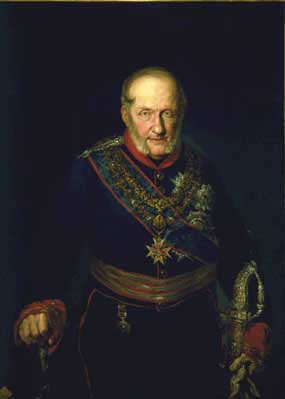
King Francis I wearing the Collars of the Golden Fleece & Saint Januarius
The fall of the Neapolitan Monarchy to the French invader in 1798 led to the Order being awarded more often to non-Italians and foreign Sovereigns. The first of the latter to receive the Order was Czar Alexander I, while two Russian noblemen, Admiral Feodor Ouchakov and Count Vassili Vassilievitch Levachov, were exempted from the limitation to Roman Catholics. During the period of the Napoleonic wars the Order was given to more foreigners than at any time in its history, including Landgraf and Prince Ludwig of Hesse-Phillipsthal (nominated in 1802), Prince Regent George (later King George IV) of Great Britain, King Carlo Felice of Sardinia, Prince Clement von Metternich-Winneburg and Prince Charles-Maurice de Talleyrand-Perigord, Duke of Dino, all nominated in 1816 and a number of British officers, the most notable of whom was Field Marshal the Duke of Wellington (nominated in 1816). [2-13]
Originally the Order had four principal officers whose duties were to administer its affairs, a Chancellor, Master of Ceremonies, Treasurer and Secretary, all of whom wore a slightly different breast star to the ordinary Knights. These duties were limited by a reform of August 17th 1827, to certain ceremonial roles at the installation of Knights (no successors were appointed to the then holders of these offices), [2-14] and the administration was confided to the Secretary, who, since 1860 has always been a Knight of the Order. he first officers of the Order were the Most Rev. Don Mondillo Orsini, Archbishop of Capua and nephew of Pope Benedict XIII (as Chancellor) who was also appointed a Knight in the first promotion, Don Giovanni Brancaccio, another Minister (as Treasurer) who could not make the full noble proofs and was never appointed a Knight and Don Gaetano Brancone (as Secretary), who was likewise never made a Knight; all three were nominated to their posts on the same day as the publication of the Statutes (July 3rd 1738). Marchese Bernardo Tanucci, the Secretary of State, was appointed Master of Ceremonies two months later on September 13th and was admitted as a Knight in 1764, In practice, as the principal Secretary of State, Tanucci controlled the Order and, after King Charles went to Spain, the affairs of the Kingdom, until King Ferdinand attained his majority.
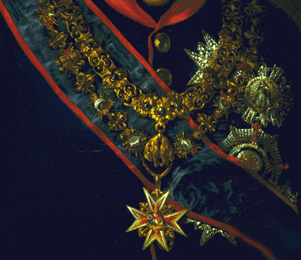
Detail of the Collar of Saint Januarius from the Portrait of Francis I
The Order was rarely at its full complement of sixty Knights, although in the last two years of the Monarchy there were sixty-five appointments, extending its membership considerably, of whom twenty-seven were non-Neapolitans, mainly foreign diplomats. 1861, the year in which the King was forced into permanent exile, saw a further extension of its membership as thirty-four new Knights were admitted, most of whom were Neapolitan and Sicilian noblemen who had remained loyal to the King. Many of the other Knights had immediately accepted office under the Savoy Kings and may be presumed to have forfeited membership by breaking their oath of loyalty to the Grand Master. Certain Sovereigns continued to maintain diplomatic relations with the exiled Court, including the Emperor of Austria, the Kings of Bavaria, Wurtemberg and Hanover, the Queen of Spain, the Czar of Russia, and the Pope, all of whose Ambassadors received the Order between 1862 and 1870. From 1870 until the death of King Francis II, the Order was only rarely awarded, to a few former subjects who had remained loyal, the elder sons of the Count of Caserta, the former reigning Duke of Parma and his brother the Count of Bardi (both nominated in 1883), the reigning Prince of Monaco and Ferdinand, Prince and later Czar of the Bulgarians (nominated in 1891).
The succession of the Count of Caserta marked a substantial increase in importance of the Constantinian Order, while the Order of Saint Januarius continued to be given only rarely. Between the death of King Francis on December 27th 1894 and the death of the Count of Caserta on May 26th 1934, only thirty-one appointments were made, of whom the first four (and a further two) were Cardinals and including those of his sons who had not been nominated by Francis II, other than Prince Don Gabriele (who was appointed by Prince Don Ferdinand-Pius). The next Grand Master, Ferdinand-Pius, who died in 1960, only made two appointments to the Order, Prince Don Gabriele and Don Filippo Lancellotti, Prince of Lauro (who died in 1970). [2-15] Ferdinando-Pio's next brother, Prince Don Carlo, had been appointed a knight of Saint Januarius by his father the Count of Caserta, but Prince Don Carlo's only surviving son, the Infante Don Alfonso had never received the Order. Nonetheless, with the death of his uncle Ferdinando-Pio, the Infante Don Alfonso succeeded to the Headship of the Royal House of the Two Sicilies and Grand Magistery of Saint Januarius by virtue of the laws of succession of the Kingdom and the Pragmatic Decree of Charles III of October 6th, 1759. [2-16]
Since 1960 the Order has been awarded sparingly and total membership (including Royal Princes) has not exceeded eighty, most of the knights being members of Royal Houses, senior officers of the Constantinian Order or Italian grandees. The Infante Don Carlos, Duke of Calabria and his late father, both followed the example of the nineteenth century Sovereigns of the Two Sicilies in awarding the Order not only to the heads of other Royal Houses (or reigning Sovereigns), but also to their closest advisers, several of whom also hold high office in the Constantinian Order. [2-31]
Footnotes
[1]" aveva (il Re Carlo) con alcune regole e capitoli, a gloria dell'Onnipotente Iddio, per difesa e propagazione della Cattolica Religione, e per aumento della Cristiana pieta, istituita gia una lodevole Compagnia, o sia un Ordine di Nobili Cavalieri, a somiglianza dell'altro celebre Ordine denominato del Tosone d'Oro, sotto il titolo, invocazione, e patrocinio di San Gennaro, Vescovo e Martire...., del quale Capo e Primate il Re medesimo,e chiunque legittimamente gli succederebbe.... in virtu della presente, coll'Apostolica Autorita, approviamo e confermiamo la prenominata Compagnia ed Ordine, sotto il patrocinio ed invocazione di San Gennaro, aggiungendo all sua fondazione il vigore di una perpetua ed inviolabile fermezza".
[2] The first names proposed by King Philip as candidates for the dignity of Magnate and included in a letter dated 4 February 1738 were:
[3] By proxy on May 9th and in person on June 19th 1738.
[4] While the Bavarian Order of Saint Hubert was not given its present form until 1800, it had been reformed from the Order founded by the Duke of Cleves and Julich in 1444 and was awarded by the Wittelsbach Electors throughout the 18th century.
[5] Those Charles appointed without consulting his father were the Prince of Santobuono, the Prince of Montemileto, Marquess Giuseppe Spinelli di Fuscaldo, Constable of the Kingdom Colonna, the Duke of Atri, the Count of Fuenclara, and the Count of Wackerbarth (letter of 8 July 1738).
[6] Piedras Alta was created a Grandee of the 1st Class 15 December 1739.
[7] Later admissions included a number of distinguished persons who could not prove the necessary four quarters and several gentlemen not of noble birth were admitted by special concession of the Grand Master during the 19th century, including: François-Pierre-Guillaume Guizot (1846), sometime Prime Minister of Louis-Philippe, King of the French; M. Jules Malon and M. Adolphe Deschamps (1847), both Belgian Ministers; the French General Antoine Gemeau (1851); Adolphe Barrot (1852), French Minister; Edouard Drouin de Lhuys (1852), French Foreign Secretary; Senator Count Rognet (1859), Aide-de-Camp to Napoleon III; Baron Alexandre Brenier (1859), French Ambassador in Naples; Ferdinando Troia (1856), sometime Prime Minister of Naples; and Lt-Gen Massimo Selvaggi (1849).
[8] Giovanni Maresca (Duke della Salandra), whose conclusions are disputed by this author, has stated that this distinction was made on the basis that the Knights of Justice had to be the primogeniture heirs of the heads of feudal, titled families and that such gentlemen could not be admitted to that category unless they already held the charge of Gentiluomo di Camera. He also wrote that provided the candidate had the necessary qualities of high morals and loyalty to the Sovereign, the honor of Knight of Saint Januarius could be demanded by right, thus becoming quasi-hereditary. At the death of Ferdinand II, by the Duke della Salandra's calculations, there were thirty-four knights of Justice and thirteen knights of Grace. See Giovanni Maresca,"Precisazione...", in Rivista Araldica, 1965, p.122. See also Luigi Buccino Grimaldi in The Golden Age of Naples - Art and Civilization Under the Bourbons 1734-1805, Exhibition Catalogue, Vol II, Detroit Institute of Arts, 1981, p. 448.
[9] He was nominated on 6 September 1740, although this nomination does not appear in the Rolls published in 1748 and 1764, nor in the works of Serra, Litta, Candida Gonzaga, Bonazzi or Di Lorenzo.
[10] "ROYAL DECREE OF NOVEMBER 23 1738 - So that it may be determined in which manner the Clergymen who shall be elevated by Us as Knights of the Royal Order of Saint Januarius shall receive the Cross from our hands and the manner in which they shall wear it in daily and state functions, We declare that Cardinals, Archbishops and Bishops, in order to be admitted to the Order, shall receive the Cross from Us, and for such purpose, shall appear in the Royal Chapel. The Cardinals shall appear for the first time only in their Cardinal's robes, and the Archbishops and Bishops in their own prelates robes, and having taken the usual oath, the Cross shall be presented to them by Us with the red, moire ribbon that they must always wear around their neck. / At subsequent public and state functions of the Order, the Cardinals shall be presented with their Cardinals robes and the Archbishops and Bishops in their prelates robes, wearing the aforesaid Cross around their necks. / When they dress informally. besides the aforesaid Cross around their necks, they shall also wear on their breast, on the left side of their plain coat and at the same time on the left side of their mantle, the embroidered Cross with the motto: "In Sanguine Foedus", the same as the lay Knights of the Order. / Naples, 23 November 1738 / CHARLES G.M."
[11] Nominated 25 January 1739.
[12] Prince Francesco Gonzaga Pico della Mirandola e Este, Prince of Mantua, Duke of Solferino, nominated 6 September 1740.
[13] Later 1st Duke of Montealegre (8 June 1740), nominated 20 October 1738.
[14] 1st Duke of Losada & Grandee of the 1st Class, nominated 20 October 1738.
[15] Letter from the Marques de Salas to King Philip, 21 October 1738.
[16] Nominated 6 September 1740, but not included in the Rolls (see note 6 above).
[17] Nominated 6 September 1740 and likewise excluded from the Rolls (see note 6).
[18] Never nominated.
[19] Never nominated.
[20] Nominated 6 September 1740.
[21] Nominated 15 June 1747.
[22] Never nominated.
[23] Never nominated.
[24] Never nominated.
[25] Neither of these were nominated. These records, located by the Marques de Floresta, are located in AHN, ESTADO, leg. 6349, Carpetas 1, 2,3,5,& 6.
[2-1]" aveva (il Re Carlo) con alcune regole e capitoli, a gloria dell'Onnipotente Iddio, per difesa e propagazione della Cattolica Religione, e per aumento della Cristiana pieta, istituita gia una lodevole Compagnia, o sia un Ordine di Nobili Cavalieri, a somiglianza dell'altro celebre Ordine denominato del Tosone d'Oro, sotto il titolo, invocazione, e patrocinio di San Gennaro, Vescovo e Martire...., del quale Capo e Primate il Re medesimo,e chiunque legittimamente gli succederebbe.... in virtu della presente, coll'Apostolica Autorita, approviamo e confermiamo la prenominata Compagnia ed Ordine, sotto il patrocinio ed invocazione di San Gennaro, aggiungendo all sua fondazione il vigore di una perpetua ed inviolabile fermezza".
[2-2] By proxy on May 9th and in person on June 19th 1738.
[2-3] Later admissions included a number of distinguished persons who could not prove the necessary four quarters and several gentlemen not of noble birth were admitted by special concession of the Grand Master during the 19th century, including: François-Pierre-Guillaume Guizot (1846), sometime Prime Minister of Louis-Philippe, King of the French; M. Jules Malon and M. Adolphe Deschamps (1847), both Belgian Ministers; the French General Antoine Gemeau (1851); Adolphe Barrot (1852), French Minister; Edouard Drouin de Lhuys (1852), French Foreign Secretary; Senator Count Rognet (1859), Aide-de-Camp to Napoleon III; Baron Alexandre Brenier (1859), French Ambassador in Naples; Ferdinando Troia (1856), sometime Prime Minister of Naples; and Lt-Gen Massimo Selvaggi (1849).
[2-4] Giovanni Maresca (Duke della Salandra), whose conclusions are disputed by this author, has stated that this distinction was made on the basis that the Knights of Justice had to be the primogeniture heirs of the heads of feudal, titled families and that such gentlemen could not be admitted to that category unless they already held the charge of Gentiluomo di Camera. He also wrote that provided the candidate had the necessary qualities of high morals and loyalty to the Sovereign, the honor of Knight of Saint Januarius could be demanded by right, thus becoming quasi-hereditary. At the death of Ferdinand II, by the Duke della Salandra's calculations, there were thirty-four knights of Justice and thirteen knights of Grace. See Giovanni Maresca,"Precisazione...", in Rivista Araldica, 1965, p.122. See also Luigi Buccino Grimaldi in The Golden Age of Naples - Art and Civilization Under the Bourbons 1734-1805, Exhibition Catalogue, Vol II, Detroit Institute of Arts, 1981, p. 448.
[2-5] "ROYAL DECREE OF NOVEMBER 23 1738 - So that it may be determined in which manner the Clergymen who shall be elevated by Us as Knights of the Royal Order of Saint Januarius shall receive the Cross from our hands and the manner in which they shall wear it in daily and state functions, We declare that Cardinals, Archbishops and Bishops, in order to be admitted to the Order, shall receive the Cross from Us, and for such purpose, shall appear in the Royal Chapel. The Cardinals shall appear for the first time only in their Cardinal's robes, and the Archbishops and Bishops in their own prelates robes, and having taken the usual oath, the Cross shall be presented to them by Us with the red, moire ribbon that they must always wear around their neck. / At subsequent public and state functions of the Order, the Cardinals shall be presented with their Cardinals robes and the Archbishops and Bishops in their prelates robes, wearing the aforesaid Cross around their necks. / When they dress informally. besides the aforesaid Cross around their necks, they shall also wear on their breast, on the left side of their plain coat and at the same time on the left side of their mantle, the embroidered Cross with the motto: "In Sanguine Foedus", the same as the lay Knights of the Order. / Naples, 23 November 1738 / CHARLES G.M."
[2-6] The first-born son being retarded, the king's second-born son, Charles, became Prince of the Asturias and, in 1788, Charles IV of Spain - he was the ancestor of the present Spanish king.
[2-7] "In quanto a cio che mi domandi relativamente alle notizie sull'Ordine di San Gennaro, ti diro' che io non ho creduto conveniente rinunziare a quest'Ordine a favore di Mio figlio il Re quando sono partito, e me lo sono riservato come fondatore, e tale rinunzia faro' quando Egli sia diventato maggiorenne, di modo che puoi agire in base a queste disposizioni. Buon Ritiro, 30 settembre 1760. CARLO (rubricato) ." General Archives of Simancas, Secretariat of State, Kingdom of the Two Sicilies, 18th century, series 3, folio 136, right, line 11 ff.
[2-8] Translation from the original Italian; Archives of Simancas, n. 5.878, folio 139
[2-9] This letter, found in the National Historical Archives in Madrid, Section of State, file number 3.795, is reproduced in La Maison Royale des Deux Siciles, L'Ordre Constantinien de Saint Georges et L'Ordre de Saint Janvier, by the Marquess of Villarreal de Alava, Madrid 1964, pp. 692-697.
[2-10] Prof. Giacomo Carlo Bascape in his history of the Order published on behalf of Prince Ranieri, has stated that the resignation was made in 1764. The Marquess of Villarreal de Alava, Op. cit. 1964, pp.472-473 and 554-562, has shown conclusively that the transfer was made formally on December 9th 1766: "My dear and much beloved son./ When the All Powerful summoned me to the Throne of Spain following the death of King Ferdinand VI, my very dear and much beloved Brother, conforming to the spirit of the Treaties of this century I established, by a solemn act and law promulgated on the 6 October 1759, the succession to the Kingdom of the Two Sicilies in the person of Your Majesty ......... Finding that Your Majesty has almost attained Your majority, I believe that it is necessary that I should explain something which I have had in mind and declare that the Sovereignty and the Grand Magistery of the Order of Saint Januarius pertains to Your Majesty and Your successors as Kings of the Two Sicilies, fully and absolutely, as it pertained to me as Founder.// And in order that immediately Your Majesty is placed in full possession of Your authority that You shall be Head, Sovereign and Grand Master of the aforesaid Order, I ordain this in the form of a most solemn and express declaration by this my decree signed by My hand and witnessed by the undersigned Councilor and First Secretary of State and Dispatch. May Our Lord protect Y.M. my very dear and much beloved son, for as many years as He may grant you. San Lorenzo 9 december 1766. // I THE KING // Geronimo de Grimaldi."
[2-11] This corrected many of the mistakes and omissions in the Roll published at Naples in 1885 by Francesco Bonazzi.
[2-12] See Villarreal de Alava, Op.cit., pp.489-553, in which the first members of the Order, listed in the Roll only by their titles of nobility, are each correctly identified. Three Royal Princes were included, the Infantes Don Filippo (Duke of Parma) and Don Luis, and the King's brother-in-law the Electoral Prince Friedrich Christian of Saxony, Prince of Poland, and two Cardinals, Lodovico Belluga and Troiano Acquaviva d'Aragona. Recent research by the present author has indicated that the Rolls published in Naples also omitted the names of some 19th century members of the Order - for example, the Grand Chancellor of the Legion of Honor on 14 December 1830 granted permission to the Marquis de Dreux-Brezé, formerly hereditary Grand Master of Cermonies of the French Court, who had been nominated on 27 July 1830, to accept the Order, although his name is not listed in any of the published Rolls. The family names of many of the first Knights can be found on the recent Rolls of the Order of Saint Januarius and the Constantinian Order, including Moncada, Caracciolo, Colonna, de Córdoba, and di Sangro. Over the next sixty years, other families of which members are or have been recent supporters of the present Grand Master include the names Gonzaga, Fitzjames Stuart, Osorio de Moscoso, Alliata, and Pignatelli.
[2-13]The first British knight was John Joseph (sometimes called James) O'Mahony, 2nd Count of Mahony, a Lieutenant-General in the Neapolitan Army and son of a leading Jacobite, Daniel O'Mahony, created a Count by Philip V of Spain (9 Nov 1706), by Lady Ann Clifford, daughter of the Hon. Thomas Clifford and Charlotte, suo jure 3rd Countess of Newburgh. He was nominated on June 15th 1747 and is the ancestor of the present Earl of Newburgh. The next British knights were Admiral of the Fleet Sir George Martin (nominated in 1810), Lt-Gen Thomas (Mahon), 2nd Baron Hartland (nominated in 1816), Lt-Gen Sir John Du Platt (nominated in 1816), Lt-Gen Sir William Phillips (nominated in 1816), Lt-Gen Sir John Murray, 8th Baronet (nominated in 1817), Rear-Admiral Sir David Milne (nominated in 1818), General John (Fane), Lord Burghersh, later 11th Earl of Westmoreland, GCB, GCH, Minister Plenipotentiary of His Britannic Majesty (nominated in 1825), General James Ochoncar (Forbes), 17th Lord Forbes (nominated in 1829), the Rt Hon (and Hon.) Sir Henry Elliot, PC, GCB, Envoy and Minister Plenipotentiary at Naples in 1859, who died in 1907 at the age of eighty-nine (nominated in 1859), and His Eminence the Most Rev. Nicholas, Cardinal Wiseman, Archbishop of Westminster (nominated in 1859), most of whom did not fulfill the statutory requirement of being Roman Catholics.
[2-14] "Francis I, King of the Kingdom of the Two Sicilies, of Jerusalem, etc, Duke of Parma, Piacenza, Castro, etc, Hereditary Grand Prince of Tuscany, etc. // Having reviewed Chapter VIII of the Statutes of Our Illustrious Royal Order of Saint Januarius, by which Our glorious ancestor, Charles III, established four Officers of the aforesaid Order; that is, the Chancellor with the assignment of dubbing the Knights; the Master of Ceremonies, with the task of regulating the ceremonial functions; the Treasurer with the duty of preserving the style of dress and the Cross, the Royal Collars not yet bestowed, the processes of the proofs of nobility, and the Book of Statutes; and finally, the Secretary, with the responsibility of sending dispatches, letters, diplomas and anything else pertaining to the administration of the Order and the promotion of Knights. / Taking into consideration that presently the affairs of the this and all other Royal Orders are exclusively under the Royal Secretariat and the Ministry of State for the Royal Household: / On the proposition of Our Councilor Minister of State, the Minister Secretary of State for the Royal Household and of Orders of Knighthood, we have resolved to decree and decree as follows: / Art.I We repeal in part the Statutes of the Illustrious Royal Order of Saint Januarius only in that section pertaining to the assignments given to the four Officers of this Royal Order. / Art.II All affairs concerning the Royal Order of Saint Januarius shall continue to be handled, as they are presently, by the Royal Secretariat and the Ministry of State of the Royal Household and of the Orders of Knighthood. / Art.III We desire that the aforesaid four Officers of the Order shall retain only those functions that need to be exercised in the maintenance of the Royal Chapels of the aforesaid Order, following what was prescribed for the established rituals as ordained at its institution by His Majesty King Charles III, of glorious memory. / Art.IV The four Officers of the Royal Order of Saint Januarius having been nominated by Us, they shall take the oath and shall wear the decorations in the manner prescribed in the aforesaid statutes. / Art.V Our Councilor Minister of State, the Minister Secretary of the Royal Household and of the Orders of Knighthood is charged with the execution of the present decree. / Naples 28 July 1827. / FRANCESCO G.M."
[2-15]At the time of the death of Ferdinando Pio, Duke of Calabria, in 1960, the only surviving members of the Order were Princes Don Ranieri and Don Gabriele of the Two Sicilies (Prince Don Charles having died in 1949), and the Prince of Lauro.
[2-16] He also succeeded as Xth Grand Master of the Sacred Military Constantinian Order of Saint George.
[2-31] The Dukes of Castro, in contrast, have preferred to accord the Order to the representatives of great Italian families and members of the Two Sicilies dynasty, the only exceptions being the present and preceding Grand Masters of the Sovereign Military Order of Malta, the late King Umberto II of Italy, one Cardinal and three non Italian members of their Constantinian Deputation.

